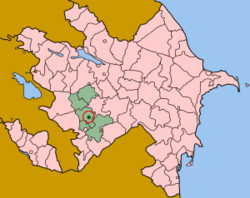This is an old revision of this page, as edited by ArmenianNY (talk | contribs) at 15:03, 3 February 2007 (minor). The present address (URL) is a permanent link to this revision, which may differ significantly from the current revision.
Revision as of 15:03, 3 February 2007 by ArmenianNY (talk | contribs) (minor)(diff) ← Previous revision | Latest revision (diff) | Newer revision → (diff) Place| Stepanakert
ՍտեփանակերտKhankendi (Xankəndi) | |
|---|---|
| Parliament building in Stepanakert.Parliament building in Stepanakert. | |
 Map of Azerbaijan showing the town of Stepanakert within Nagorno-Karabakh. Map of Azerbaijan showing the town of Stepanakert within Nagorno-Karabakh. | |
| Province | Stepanakert (City) |
| Government | |
| • Mayor | Eduard Aghabekian |
| Elevation | 810 m (2,670 ft) |
| Population | |
| • Total | ~40,000 |
Stepanakert (Armenian: Ստեփանակերտ; officially known as Xankəndi in Azerbaijan, transliterated as Khankendi) is the capital city of the Nagorno-Karabakh Republic, a de-facto independent republic which is officially part of Azerbaijan.. The city has a population of about 40,000. As of 2007, Stepanakert, like most of Nagorno-Karabakh, remains under Armenian military control, and the entire local Azerbaijani population has fled the city.
History
Although earlier settlements were possible, the founding of the town is traced to the late XVIII century by the Azerbaijani Karabakh khan, and was thus called Khankendi (Khan's village in Azerbaijani). In 1923 it was renamed to Stepanakert, to honor Stepan Shahumyan, an Armenian communist leader from Baku, and upgraded to a city status, becoming the new regional capital of the newly created Nagorno-Karabakh Autonomous Oblast (NKAO). In 1991, the Soviet Azerbaijani government restored the name of the city back to Khankendi. The local inhabitants and the authorities of unrecognized Nagorno Karabakh Republic keep calling the city Stapanakert.
Economy

Prior to the war, Stepanakert's economy revolved mostly around food processing, silk weaving, and winemaking. After the war, the city's economy was greatly damaged, but in recent years, largely due to the investments of the Armenian Diaspora, economic activity has picked up in Stepanakert.
Buildings and structures
Religious
There is not a traditional church in Stepanakert as of (2007) although most of the population of the city are Christians. The believers attend the church that is in the building of the House of Culture. There is one ancient church in the city that was build in the 18th century, but it is not operating. On September 15, 2006 the foundation stones of St. Jacob Church in Stepanakert were laid. Armenian benefactor Vache Yepremian from Los Angeles is sponsoring the construction of the church. Its construction will probably last for 2-3 years.
It is also the home of the Artsakh State Museum.
Sister cities
 Montebello, California, USA (2005)
Montebello, California, USA (2005)
References
- 1993 UN Security Council Resolutions on Nagorno-Karabakh, US State Department, accessed February 1, 2007 http://www.state.gov/p/eur/rls/or/13508.htm
External links
- Nagorno-Karabakh Nagorno-Karabakh's website
- Karabakh’s Election Conundrum November 2005 article about elections for seats in the Milli Mejlis (Azerbaijani parliament) for Azeri refugees
- Stepanakert Armeniapedia atricle
| Administrative divisions of Artsakh | ||
|---|---|---|
| Capital city | ||
| Provinces | ||
| Provincial capitals | ||
| Other urban communities |
| |